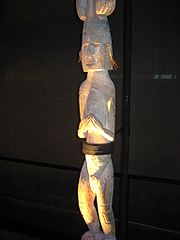
Bisj Pole
Encyclopedia


Asmat people
The Asmat are an ethnic group of New Guinea, residing in the Papua province of Indonesia. Possessing one of the most well-known and vibrant woodcarving traditions in the Pacific, their art is sought by collectors worldwide...
of south-western New Guinea
New Guinea
New Guinea is the world's second largest island, after Greenland, covering a land area of 786,000 km2. Located in the southwest Pacific Ocean, it lies geographically to the east of the Malay Archipelago, with which it is sometimes included as part of a greater Indo-Australian Archipelago...
. Objects similar to Bisj Poles are found among many peoples of the South Pacific
Pacific Islands
The Pacific Islands comprise 20,000 to 30,000 islands in the Pacific Ocean. The islands are also sometimes collectively called Oceania, although Oceania is sometimes defined as also including Australasia and the Malay Archipelago....
islands - in New Zealand
New Zealand
New Zealand is an island country in the south-western Pacific Ocean comprising two main landmasses and numerous smaller islands. The country is situated some east of Australia across the Tasman Sea, and roughly south of the Pacific island nations of New Caledonia, Fiji, and Tonga...
, and on Vanuatu
Vanuatu
Vanuatu , officially the Republic of Vanuatu , is an island nation located in the South Pacific Ocean. The archipelago, which is of volcanic origin, is some east of northern Australia, northeast of New Caledonia, west of Fiji, and southeast of the Solomon Islands, near New Guinea.Vanuatu was...
.
Carved out of a single piece of a wild nutmeg tree, Bisj poles can reach heights of up to 25 feet (7.62 m), and consist of human figures standing on top of each other, as well as animal figures, phallic symbols, and carvings in the shape of a canoe prow. Bisj poles were carved by the religious carvers of the Asmat (wow-ipits) after a member of the tribe or community had been headhunted (killed) by an enemy tribe. The Asmat participated in headhunting raids and cannibalism as ritual. The Asmat believed that if a member of the community had been headhunted, his spirit would linger in the village and cause disharmony. Bisj poles were erected in order to satisfy these spirits and send them to the afterlife (Safan) across the sea. Many rituals were involved in the Bisj poles including dancing, masquerading, singing and headhunting--all performed by men. Bisj poles often had a receptacle at the base that was meant to hold the heads of enemies taken on headhunting missions. The phallic symbols represented the strength and virility of the community's ancestors as well as of the warriors going on the headhunting mission. Canoe prow symbols represented a metaphorical boat that would take the deceased spirits away to the afterlife. The human figures would represent deceased ancestors. Bisj poles were erected primarily as an act of revenge, to pay homage to the ancestors and to bring harmony and spiritual strength to the community. Although headhunting ended in the Asmat region in the 1970s, the poles are still used in rituals today.
Further reading
- Van der Zee, Pauline, Etsjopok: Avenging the Ancestors. The Asmat Bisj Poles and a Proposal for a Morphological Method. Working Papers in Ethnic Art 8 (University of Ghent, Department of Ethnic Art). Ghent, 1996.
- Van der Zee, Pauline, Bisj-poles: Sculptures from the Rain Forest. Amsterdam: KIT Publishers, 2007. ISBN 978 906832 4785

